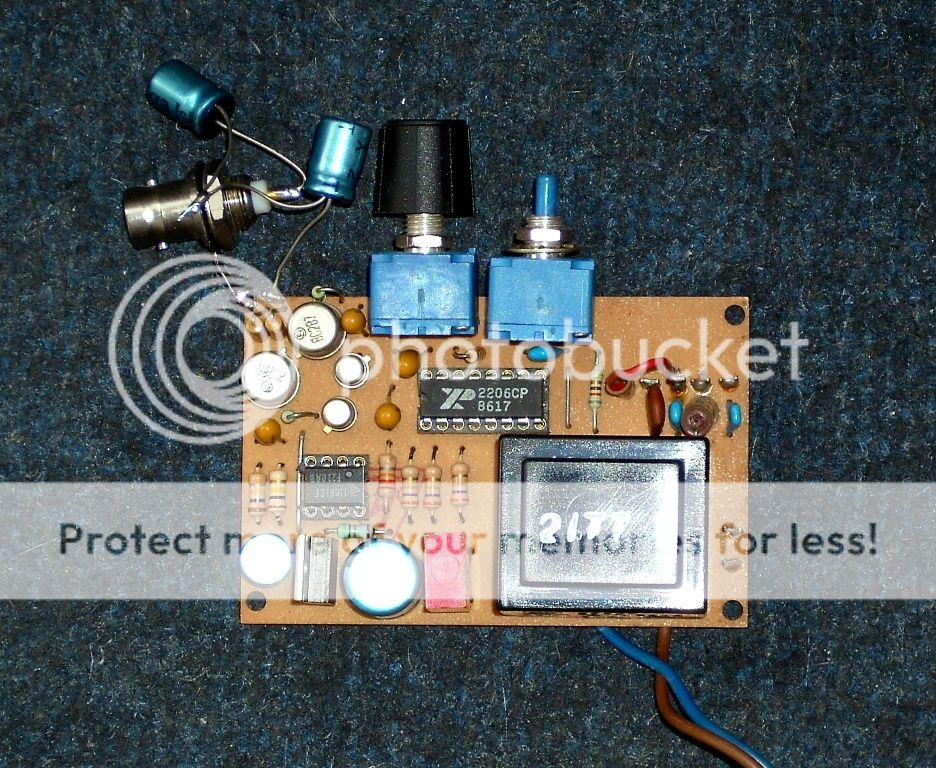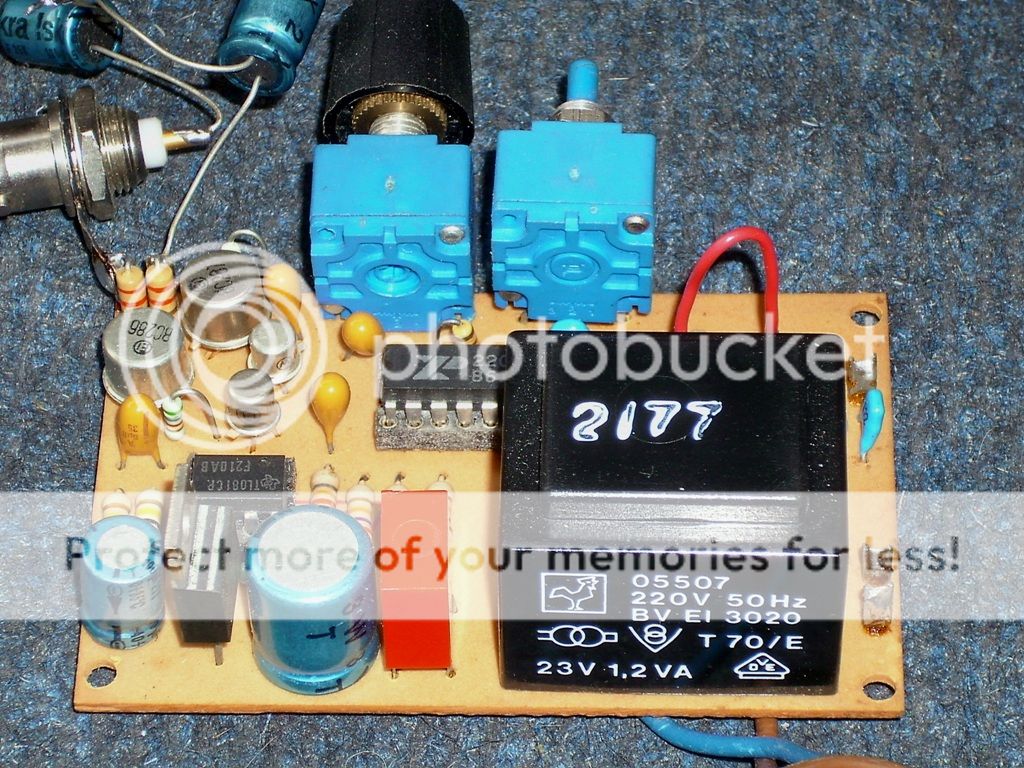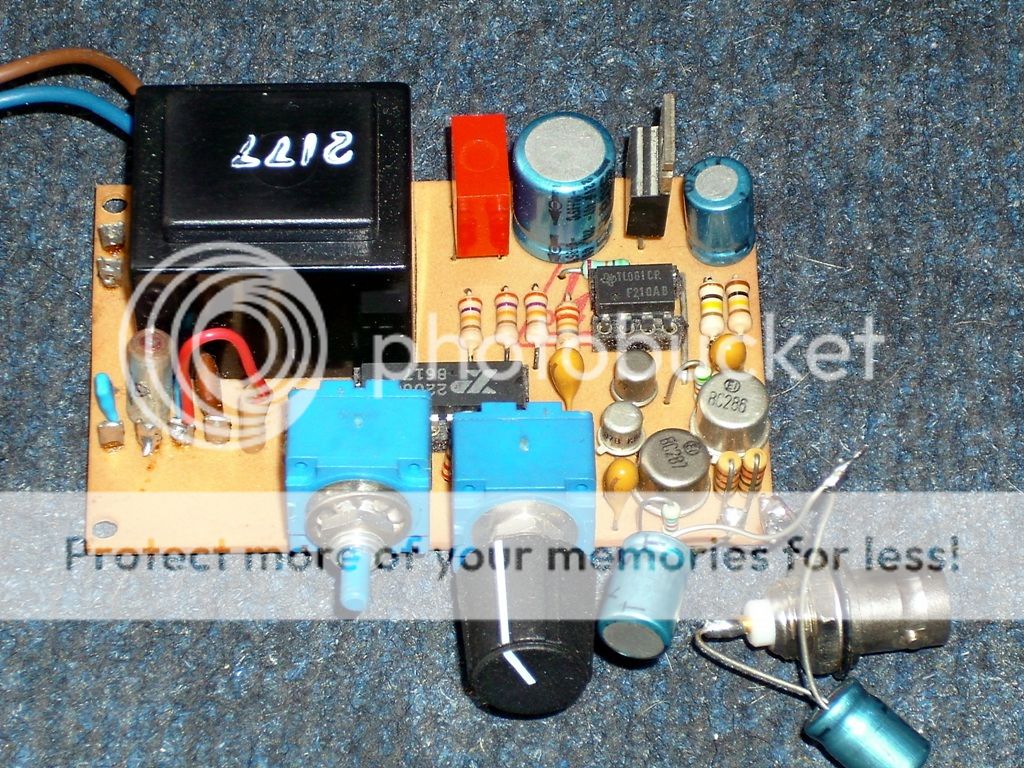Usuallly, it's better if starting out with a sinewave generator, to square up and drive a HEX of series/parallel Schmitt inverters. These will drive any line OK but if you want 50R power, a DMOS buffer like VN10KM, 2N7000, BS250 will drive suitable loads at < 40 nS risetime/5V amplitude. Plenty for audio, anyway. You could even feed the CMOS 555 output into that buffer, too.
Have a look at the Squarewave output circuit on the schematic in #12. That explains the arrangement and is quite good, if you want something capable.
Have a look at the Squarewave output circuit on the schematic in #12. That explains the arrangement and is quite good, if you want something capable.
I have tried a schmitt trigger fed by a sinus wave. I cannot get rid of ringing at transitions.
It even pollutes the sinewave. Though the sinus generator and the trigger have two separate PSU.
The damped oscillation is at about 10Mhz. So the 100khz square looks dirty.
I do not have this problem with the astable i spoke about.
It even pollutes the sinewave. Though the sinus generator and the trigger have two separate PSU.
The damped oscillation is at about 10Mhz. So the 100khz square looks dirty.
I do not have this problem with the astable i spoke about.
Last edited:
Did you see the discrete squaring circuit that goes between the oscillator and schmitt trigger, in the link? I recall a simpler version back when the XR2206 was popular and I built a few function generators similar to the Elektor circuit(s) then. I can say that with fast PNP switching transistors (2N4258), a good layout and strategic bypass caps on the 5V rail, it is very clean up to ~2MHz.I have tried a schmitt trigger fed by a sinus wave. I cannot get rid of ringing at transitions.
It even pollutes the sinewave. Though the sinus generator and the trigger have two separate PSU....
I have to admit that the CMOS 555 IC wasn't known then and a lot of problems were solved with its development. No one would use original 555 timers for good square waves as they just don't switch fast enough even for general purpose use. These CMOS types are a great improvement and do make it simpler at audio frequencies as you show.
MAX038 is better if RF frequencies up to 20MHz are needed but audio distortion, sweep range, duty cycle are not as good. Original 8038 (350 kHz) chips were outclassed the day Exar released the 2206 (2MHz). MAX038 is a very expensive chip now because it's also obsolete and the desirable evaluation kit is very rare.
Have you compared chip datasheet specs?
http://docs-europe.electrocomponents.com/webdocs/0da0/0900766b80da0911.pdf
MAX038CPP datasheet and application note, data sheet, circuit, pdf, cross reference | Datasheet Archive
I think DSP generator kits will be cheaper and better for HF audio test applications, provided suitable firmware is also available and you enjoy spending time programming stuff.
Have you compared chip datasheet specs?
http://docs-europe.electrocomponents.com/webdocs/0da0/0900766b80da0911.pdf
MAX038CPP datasheet and application note, data sheet, circuit, pdf, cross reference | Datasheet Archive
I think DSP generator kits will be cheaper and better for HF audio test applications, provided suitable firmware is also available and you enjoy spending time programming stuff.
I disagree with your comment.
I have played wit both chips and of course compared the datasheets and the results i get.
The Max038 chip is available for 12 bucks. Looks like it is produced again though i do not know where.
Duty cycle is adjustable/settable.
Distortion is about the same when duty cycle is adjusted. Plus there is no glitch on the sine wave.
Sweep range is more than twenty times when correctly implemented, more than enough.
It is simpler to implement taking advantage of all signals are of same amplitude on one output symmetrical to zero volts.
Square waves are available at the regular buffered output plus there is a separate sync output which can be disabled.
100khz square is perfect and even a lot higher.
Square waves are poor passed 20 khz (look at settling time) with the 2206, that is why i looked elsewhere and i am not disappointed with the result even if i do not need to go until 20 mhz.
(I have not gone farther than 10 Mhz where signal is impressively good.)
My CRO is 100Mhz so i can see the absence of damped oscillations or overshoot.
This is a good instrument for fast checking audio amplifiers behavior imo.
For precise measurements a good soundcard is needed anyway.
Digital generators are not so good at low frequencies as i can read on the web.
Edit: have you tried the Max038?
I have played wit both chips and of course compared the datasheets and the results i get.
The Max038 chip is available for 12 bucks. Looks like it is produced again though i do not know where.
Duty cycle is adjustable/settable.
Distortion is about the same when duty cycle is adjusted. Plus there is no glitch on the sine wave.
Sweep range is more than twenty times when correctly implemented, more than enough.
It is simpler to implement taking advantage of all signals are of same amplitude on one output symmetrical to zero volts.
Square waves are available at the regular buffered output plus there is a separate sync output which can be disabled.
100khz square is perfect and even a lot higher.
Square waves are poor passed 20 khz (look at settling time) with the 2206, that is why i looked elsewhere and i am not disappointed with the result even if i do not need to go until 20 mhz.
(I have not gone farther than 10 Mhz where signal is impressively good.)
My CRO is 100Mhz so i can see the absence of damped oscillations or overshoot.
This is a good instrument for fast checking audio amplifiers behavior imo.
For precise measurements a good soundcard is needed anyway.
Digital generators are not so good at low frequencies as i can read on the web.
Edit: have you tried the Max038?
Last edited:
I did indicate at the beginning that the MAX038 was better at high frequencies. 'No argument there and it is clear enough in the spec.
My applications of MAX038, 8038 & XR2206 use Schmitt buffers for the squarewave because the output waveform is then independent.
This allows almost any generator with precise mark:space ratio to have equally good, if not also improved square waves.
Even my ancient DIY Function generator from 1980 uses Schmitt inverters and a DMOS output stage for 50R output. There are faults
with any analog generator design but this technique levels out the differences between squarewave generator chip waveforms.
Of course, there are other buffers that do this too, as discussed.
My main use is for quick sinewave sweeps and with the previous modification, distortion is under 0.5% at 100-2,000Hz on my example.
This is my only justification for using a function gen. chip. For squarewaves only, I have used a DIY Pulse Generator for some years now
as this is fully adjustable for mark:space, and swept by any input or internally in one-shot mode. DC offset, sweep etc. can all be
simply adjusted without extra gadgets. This is a couple of HC221 dual monostables, Shottky diodes and same buffer/output as before.
The NOS price for the 038 bare chip from credible sources is more than 12 bucks from my searches but you may have other good sources.
XR2206 is mostly below 5 bucks.
My applications of MAX038, 8038 & XR2206 use Schmitt buffers for the squarewave because the output waveform is then independent.
This allows almost any generator with precise mark:space ratio to have equally good, if not also improved square waves.
Even my ancient DIY Function generator from 1980 uses Schmitt inverters and a DMOS output stage for 50R output. There are faults
with any analog generator design but this technique levels out the differences between squarewave generator chip waveforms.
Of course, there are other buffers that do this too, as discussed.
My main use is for quick sinewave sweeps and with the previous modification, distortion is under 0.5% at 100-2,000Hz on my example.
This is my only justification for using a function gen. chip. For squarewaves only, I have used a DIY Pulse Generator for some years now
as this is fully adjustable for mark:space, and swept by any input or internally in one-shot mode. DC offset, sweep etc. can all be
simply adjusted without extra gadgets. This is a couple of HC221 dual monostables, Shottky diodes and same buffer/output as before.
The NOS price for the 038 bare chip from credible sources is more than 12 bucks from my searches but you may have other good sources.
XR2206 is mostly below 5 bucks.
- Status
- This old topic is closed. If you want to reopen this topic, contact a moderator using the "Report Post" button.
- Home
- Amplifiers
- Solid State
- xr2206 problems


